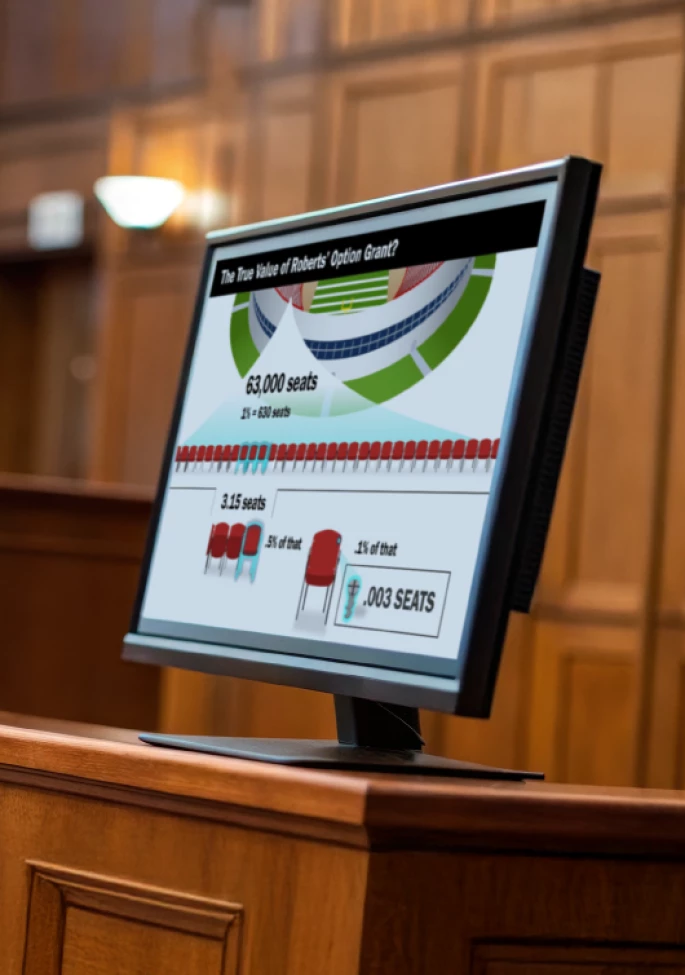Dan Martin, Trial Consulting Lead at IMS Legal Strategies, shared his predictions concerning the types of trial technology that attorneys soon will be seeing—and using—in the courtroom and in online trials.
When Dan Martin first started in the trial consulting profession 25 years ago, the practice of videotaping depositions was still fairly novel. Today, not only are many depositions videotaped, but their capture is often accomplished remotely.
The attorneys Dan partnered with in the ’90s were still arriving at trial laden with graphics printed on large boards, a presentation medium that, while not forgone, has largely been supplanted by video displays. He has seen Ultra HD (4K) video slowly begin to take the place of plain old HD, which took the place of standard definition...and so on. Once satisfied with two-dimensional graphic images, clients are increasingly requesting 3D animations.
And the swiftest legal technology transformation Dan has witnessed took place about two years ago, when legal proceedings through the use of Zoom technology began to be conducted online.
Innovation in Trial Technology
As a trial consulting expert at IMS, Dan has his fingers on the pulse of the courtroom technology industry. He and his colleagues typically are not only among the first to offer new technological tools to law firms, but they also play a role in the development of these innovations and are very often the catalysts for their widespread usage in courtrooms.
When asked about courtroom tech and media trends on the horizon, Dan predicted we will continue to see a widening frontier in trial graphics that mirrors technological innovations taking place all around us.
Dan shared, “My guess is that we’ll begin to see some level of augmented reality and virtual reality technology make its way into courtroom displays available to juries. To me the question is how ubiquitous that technology will become in the coming years. Lots of courts provide jurors with their own individual display monitors. It’s not farfetched to assume that jurors will be reaching down for a headset in five or ten years.”
Augmented and Virtual Reality
Augmented reality (AR) and virtual reality (VR) are similar in that they enable people to experience 3D images virtually, but there are differences between the two technologies. AR adds virtual images to a real-life setting, while VR replaces the real-life setting with a completely virtual reality.
Dan believes AR technology might be useful, for instance, in a product liability case in which a large piece of industrial equipment is at issue. That equipment could be brought into the courtroom virtually, enabling jurors to truly comprehend its enormity and complexity. They could walk around the structure and examine it from every angle. VR, on the other hand, might be used in an environmental case, for instance, to allow jurors to fly over the scene of a contamination site, and thus, gain a sense of the scope of damage.
Holograms
Dan offered another prediction too: “We’re probably not far off from seeing hologram technology come to the courtroom. It’s pretty exciting to think of all the potential applications for storytelling, and ultimately as a teaching tool. Imagine using holograms to present an anatomy tutorial in a personal injury case or to spin a chemical compound around in front of a jury box in a biopharma patent case.”
Holographic technology is similar to AR technology in that they both can be used to bring a nonreal 3D object into a real-life space. They differ in that holograms are created by a process that uses a split laser beam and photographic plates and AR is created digitally. Also, the resolution of a hologram is lower than that of an AR image; however, the hologram has an advantage in that it can be seen with the naked eye, meaning no headsets are needed.
3D Animation
While Dan is excited to see these innovations appear in the courtroom, he said the high-tech tools his graphics team already has at its disposal, in most cases, relay information to jurors just as effectively.
“In addition to traditional trial graphics and simple 2D animation, 3D animation continues to be an amazing tool. We’ve used 3D for years to teach concepts, to put forth a version of events, or provide the lay of the land. Now we’re seeing apps that use LiDAR-type scan data to quickly develop objects in 3D space. Anyone can play with this stuff,” he continued.
Dan was referring to the new LiDAR sensor feature that is available on iPhones versions 12 Pro and up. LiDAR stands for light detection and ranging, and this technology uses waves of light pulses to generate information about the shape of an object or objects within a scene. A person with an iPhone can now download a scanner app, scan any object or scene with their phone, and then bring that scan into a 3D program (such as Blender) and use the information to create a 3D image for screen or to create a tangible model.
The 3D image created by an iPhone can even be placed directly into a PowerPoint program. Using the morph feature within that program, the object’s movements can be displayed in a series of still slides—thus allowing jurors to see the image from every angle—or the object can be entirely animated on one single slide.
Drone Footage
Dan and fellow IMS Trial Consultant Andrew Buckley recently created an internal presentation entitled Camera Obscura: A Peek Inside the Black Box of Media Production at IMS. This demonstration contained drone footage of a swamp that was remarkably crisp and clear, so our viewers felt like they were actually there.







